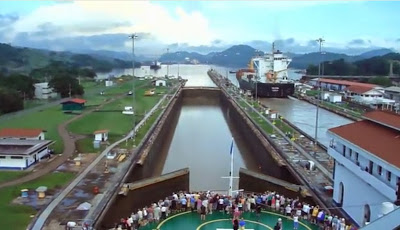The Panama Canal is undergoing an incredible expansion that will add a third set of locks and will double the capacity of the canal by 2016. Here’s a look at the 10 hour transit of the current Panama Canal condensed to just five minutes.
Amazing Facts About the Panama Canal
About 13,000 to 14,000 ships transit the canal every year. Every ship that uses the canal must pay a toll, which can run from $50,000 to $250,000 based on the ship’s size and cargo volume. The smallest toll ever paid was by American Richard Halliburton in 1928, when he swam the canal. His toll? 36 cents since he only weighed 150 pounds.
The highest toll ever paid to transit the canal was paid by the cruise ship Norwegian Pearl in 2010. Their toll was $375,600.
A ship rises 85 feet above sea level after going through the locks of the canal, and the ship’s are navigated by specially trained pilots familiar with the transit and not by the ship’s captain.
The United States gave over control of the Panama Canal to Panama in 1999. The expansion that is going on today will allow the canal to handle post-Panamx ships, or those that don’t currently fit in the Panama Canal’s locks. There will still be some ships that the canal just can’t fit, such as the Maersk Triple E class ships. These container ships are 194 feet wide and 1,312 feet long. The new locks still won’t be able to handle them since they will be 1,400 feet long and 180 feet wide.
More than 25,000 workers died constructing the canal. The French tried first and suffered more than 20,000 worker deaths while the U.S. suffered 5,600 deaths when they took over construction. The U.S. significantly reduced the deaths by controlling the spread of malaria and yellow fever. They improved sanitation measures, drained areas of standing water that bred mosquitoes and other insects, and installed screening on buildings to keep the bugs out.
Ships save 7,872 miles between New York and San Francisco by going through the canal instead of going around Cape Horn in South America.
Around four and half million cubic yards of concrete was used for constructing the dams and locks. The material excavated would circle the earth four times if it had been put on railroad flat cars.
The fastest transit of the Panama Canal was by the U.S. Navy hydrofoil Pegasus. In June of 1979, it made the trip in two hours and forty-one minutes instead of the average ten that is done today.


